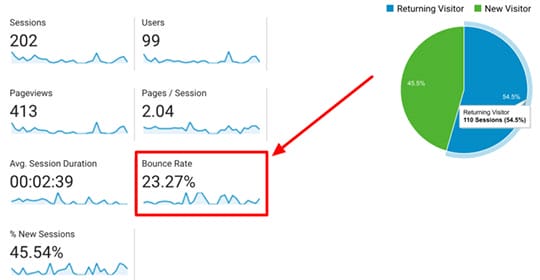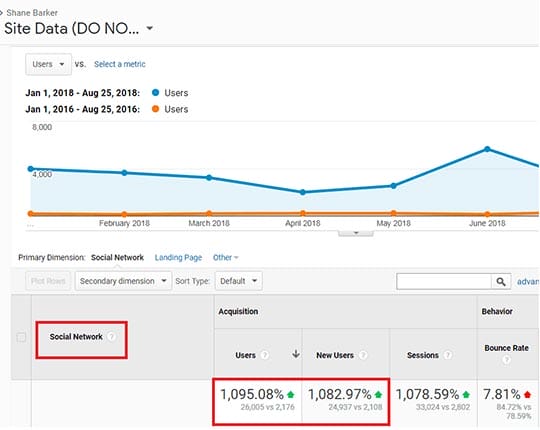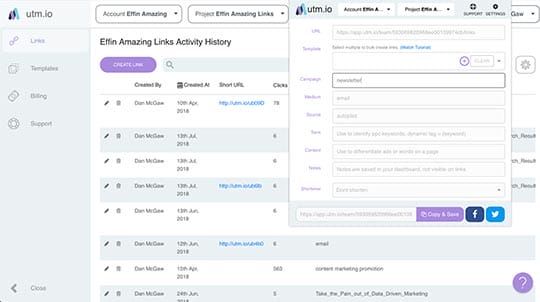Email marketing is one of the most important modes of marketing your brand. It’s known for its high ROI, and that’s why email marketing still remains popular with marketers. In fact, for every $1 invested in it, you can get up to $32 in return. However, it can take quite some time to master the art of email marketing.
Email marketing is similar to other forms of marketing in the sense that you need to set a goal when you’re starting out. Based on your goals, you can plan your email marketing campaign. There are a few common metrics that every marketer must track to judge the success of an email marketing campaign. Here are some you cannot ignore:
1. Open Rate
 The open rate of your emails is one of the basic email marketing metrics that you need to track. It helps you understand whether your subscribers are actually opening your emails or not. It gives you an idea of the percentage of subscribers who are opening your emails.
The open rate of your emails is one of the basic email marketing metrics that you need to track. It helps you understand whether your subscribers are actually opening your emails or not. It gives you an idea of the percentage of subscribers who are opening your emails.
This essentially gives you insight into the success of your email’s subject line. On average, the open rates of emails across all industries is about 15.75%. If you manage to get an open rate higher than that, then your subject line is effective.
Recommended for you: Powering Email Marketing Strategy with Marketing Automation and CRM.
2. Click-Through Rate
 Click-through rate is yet another basic email marketing metric that you should track. It shows you how many people opened your email and clicked on the link inside it. A low click-through rate can mean that the copy of the email wasn’t strong enough.
Click-through rate is yet another basic email marketing metric that you should track. It shows you how many people opened your email and clicked on the link inside it. A low click-through rate can mean that the copy of the email wasn’t strong enough.
To increase your CTR, you can add links in multiple parts of your email. It also helps if you write a solid email copy that pushes readers to click on the link. Additionally, if the links are placed in eye-catching locations and colored so that they stand out, it can improve your CTR.
Usually, your CTR will be much lower than your open rate. On average, the CTR for email marketing campaigns is about 4%.

However, you can increase the CTR by partnering with influencers and creating content with them for your emails. Adding influencers to your emails can humanize your brand. Also, on seeing the influencer’s name, the audience will start trusting your brand even further. This will push them to click on your link and that can greatly impact your click-through rates.
However, for this to succeed, you need to ensure that you find reliable influencers to collaborate with. For this, you can use tools like Influence.co and Upfluence.
3. Conversion Rate
 Your conversion rate measures how many people clicked on the link in your email and took the desired action. For instance, if you’ve got a sale, the subscribers who click on the link in the email and make a purchase count as conversions.
Your conversion rate measures how many people clicked on the link in your email and took the desired action. For instance, if you’ve got a sale, the subscribers who click on the link in the email and make a purchase count as conversions.
The conversion rate helps you get insights into the return on your investment in your email marketing campaign. This is because you’ll know how much you’ve spent and how much you’ve made from the campaign as well.
It can help you figure out whether it’s worth investing any more money in the campaign or not.
4. Bounce Rate
 The bounce rate of your email marketing campaign shows you how many emails have bounced without being delivered. It can help you figure out the quality of your subscriber list.
The bounce rate of your email marketing campaign shows you how many emails have bounced without being delivered. It can help you figure out the quality of your subscriber list.
There are two types of bounces: soft and hard. The soft bounces are due to temporary problems, while hard bounces are permanent ones.
If you have a high hard bounce rate, it means that you’ve got a lot of fake email addresses in your subscriber list. To reduce your bounce rates, you can ask subscribers to verify their email addresses after registration. This helps you improve the quality of your email list and increases email deliverability.

5. Spam Complaints
 Getting marked as spam can be very discouraging. While there might be some one-off incidents, if they start growing, you need to pay attention.
Getting marked as spam can be very discouraging. While there might be some one-off incidents, if they start growing, you need to pay attention.
If the number of spam complaints increases, the email service providers may take some action against your account. In worst cases, they may even end up blocking your account.
While the email service provider does keep track of this number for you, don’t wait for them to report an issue. By tracking it yourself, you can ensure that your emails don’t end up as spam in the inboxes of your subscribers.
6. Number of Unsubscribers
 When you send out an email, there may be a few subscribers who will unsubscribe from your email list. Finding this number is easy. Your email providers will tell you this number and may show it on your dashboard as well. If not, you can use some other email marketing tools to find this number.
When you send out an email, there may be a few subscribers who will unsubscribe from your email list. Finding this number is easy. Your email providers will tell you this number and may show it on your dashboard as well. If not, you can use some other email marketing tools to find this number.
If you’re getting a high number of unsubscribes, you may need to re-think your email marketing strategy. However, many marketers also view unsubscribes as a positive indicator that shows that your email list is getting fine-tuned.
At the same time, giving your subscribers a chance to unsubscribe from your email list helps build trust too. It lets them know that they always have a choice when it comes to receiving emails from your brand.

7. Email Share Rate
 The email sharing rate shows how much an email has been shared by recipients through social media. However, this has nothing to do with how much they’ve shared the email through email.
The email sharing rate shows how much an email has been shared by recipients through social media. However, this has nothing to do with how much they’ve shared the email through email.
This metric is only calculated if you have a “Share Now” button in your email that pushes readers to share it on social media. The rate is calculated by the number of “Share Now” clicks divided by the total number of emails and then multiplying by 100.
8. Email Forwarding Rate
 This rate shows you the percentage of emails that were forwarded to others by your recipients. It is a helpful metric that can show you the percentage of subscribers who are recommending your emails and brand to others.
This rate shows you the percentage of emails that were forwarded to others by your recipients. It is a helpful metric that can show you the percentage of subscribers who are recommending your emails and brand to others.
Converting your email subscribers into brand advocates has loads of advantages for your brand. Consumers are more likely to make decisions based on the recommendation of family or friends.

9. Mobile Open Rate
 The mobile open rate is similar to the open rate, but this metric is specifically for mobile devices such as smartphones and tablets. This rate gives you an idea of how well your email subject line performed on these smaller-screen devices.
The mobile open rate is similar to the open rate, but this metric is specifically for mobile devices such as smartphones and tablets. This rate gives you an idea of how well your email subject line performed on these smaller-screen devices.
Many people read emails on the go on their mobile devices, so you need to optimize your emails for them as well. Influencers may use mobiles to check their emails as well, so it’s crucial to craft a solid outreach email for them.
10. Campaign ROI
 The ROI of your email marketing campaign is of extreme importance, and every marketer must track it. It shows you the overall return on your investment in the campaign.
The ROI of your email marketing campaign is of extreme importance, and every marketer must track it. It shows you the overall return on your investment in the campaign.
To calculate this, you need to subtract the cost of the campaign from the total sales and divide that by the money invested in the campaign. This figure should then be multiplied by 100 to get your email marketing ROI.
You may like: How to Hack Instagram Marketing Using Influencers?
11. Mobile Click-Through Rate
 This rate is also measured just like the click-through rate on desktops. It gives you an idea of how many people opened the link in the email after opening it on their mobile devices.
This rate is also measured just like the click-through rate on desktops. It gives you an idea of how many people opened the link in the email after opening it on their mobile devices.
These rates are typically lower for mobiles as people operate loads of windows and apps at a time, hence resulting in a shorter attention span. It should be your goal to make your emails as engaging as possible. For this, you need to up your copywriting game. To improve your copywriting skills, you can check out these amazing books recommended by Kevin Payne.

12. Revenue Per Email
 While the ROI shows you the overall return on the investment of your email marketing campaign, the revenue per email gives you an idea of the performance of individual emails. This way, you’ll know which emails helped you get the most revenue and which ones didn’t.
While the ROI shows you the overall return on the investment of your email marketing campaign, the revenue per email gives you an idea of the performance of individual emails. This way, you’ll know which emails helped you get the most revenue and which ones didn’t.
Through this method, you can figure out the effectiveness of your emails and optimize your campaign to get better results.
13. Domain Open Rate
 Domain open rate gives you an idea of how well your email deliverability has fared. It lets you see the percentage of people who are opening the email from a particular email service provider.
Domain open rate gives you an idea of how well your email deliverability has fared. It lets you see the percentage of people who are opening the email from a particular email service provider.
Through this metric, you can find if your emails are performing better on one email marketing platform than others. It may also help you tell if your emails are getting stuck in the spam filter of that particular email provider.
14. Revenue Per Subscriber
 The revenue per subscriber is an email marketing metric that helps you figure out how valuable a subscriber is for your business. It’s a more profound way of looking at the ROI of your email marketing campaigns.
The revenue per subscriber is an email marketing metric that helps you figure out how valuable a subscriber is for your business. It’s a more profound way of looking at the ROI of your email marketing campaigns.
The revenue per subscriber metric helps you find out which demographics are giving better revenue than others. Using the insights from this metric, you can optimize your email marketing campaign and target more resources to the demographics that are performing better. This can help you improve your ROI, as well.

Bonus: Tracking Your Website Visits
While most email marketing platforms may show you how many people are clicking on the link in your emails, some may not. In either case, it’s always better to cross-verify this information to make it more accurate. For this, there are many tools in place such as:
1. Google Analytics

Google Analytics is one of the finest tools out there to track your website visitors. It shows you multiple metrics that can help you ascertain the behavior of your visitors as well. These include the time on site, bounce rate, number of pages per session, etc.
However, it also allows you to see how many visitors came to your website through a particular channel. This feature can help you spot the number of visitors who came through your email marketing campaigns.
2. UTM.io

To track your visitors better, you can use UTM parameters. These are short snippets that are added to the URLs that you insert in the emails. These codes are then used with Google Analytics to help you figure out the exact channel through which your traffic came. However, if you have multiple campaigns and links, it can be a task to track all these codes. In such a case, UTM.io can help you keep track of them and make the tracking from Google Analytics easy and precise.
You may also like: Your Complete Guide to Run a Perfect Influencer Marketing Campaign.
Final Thoughts

Email marketing can be very rewarding for you if done well. You need to measure as many essential metrics as possible to understand where your campaign is succeeding and where there are opportunities for improvement.
The email marketing techniques above can help you optimize your campaign and fetch you better results in the long-run. Partnering with relevant influencers can also help you maximize both the ROI and results of your email marketing campaign.
Are there other important email marketing metrics that you track? Let us know in the comments.
This article is written by Shane Barker. Shane is a digital marketing consultant who specializes in influencer marketing, content marketing, and SEO. He is the co-founder of Attrock, a digital marketing agency. He has consulted with Fortune 500 companies, influencers with digital products, and a number of A-List celebrities. Follow him: Twitter | Facebook | Instagram | LinkedIn.
 This article is written by Shane Barker. Shane is a digital marketing consultant who specializes in influencer marketing, content marketing, and SEO. He is the co-founder of
This article is written by Shane Barker. Shane is a digital marketing consultant who specializes in influencer marketing, content marketing, and SEO. He is the co-founder of 


